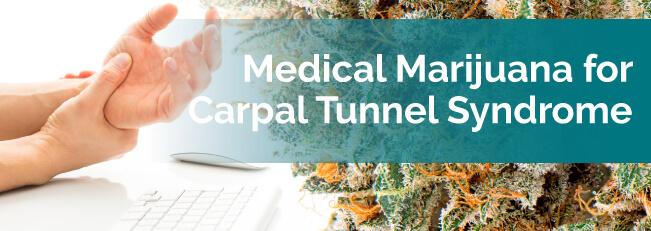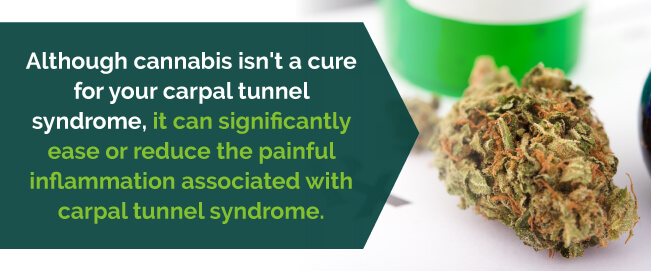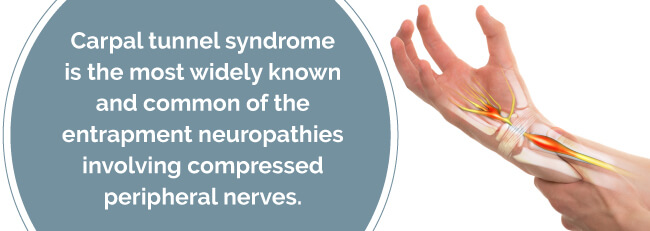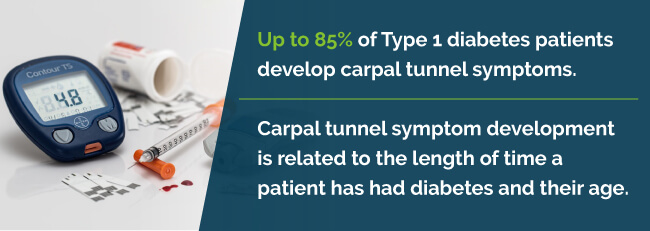
Medical cannabis is becoming popular among individuals all over the world to ease patients’ symptoms of a variety of medical conditions that do not respond well to standard interventions. Medical cannabis is also an option in cases when traditional treatments are causing unpleasant or unwanted side effects, such as addiction and risk of overdose, for examples.
Patients who suffer from wrist pain, tingling and numbness as a result of carpal tunnel syndrome have another option: medical marijuana.
Sometimes over-the-counter anti-inflammatory drugs are the best treatment for inflammation in the carpal ligaments. When symptoms worsen, doctors move up to the prescribed drugs for pain management and control, and may even issue prescriptions for anti-arthritic drugs and steroids.
The problem with this approach is your body will gradually build up a tolerance to the anti-inflammatories. Also, you can only take the steroids for so long, because they soften bones and put them at risk of breaking. Then, your doctor has to prescribe something else to strengthen the bones, or stop and start the steroids intermittently to help you find relief. The series of other possible side effects, such as weight gain, fevers, allergic reactions, etc., make it worse to take the drugs than struggle through the symptoms of carpal tunnel syndrome.
But there is hope and another alternative: carpal tunnel syndrome and medical marijuana. If you’re fortunate enough to live in a legal medical marijuana state, and you’ve run the gamut of treatments for your carpal tunnel, short of surgery, your doctor might be willing to write you a prescription for medical weed.
Marijuana has been legal in many states for quite some time now, because of the progressive thinking and research advancements on the many benefits of medical marijuana. It alleviates the pain like no other drug can — except maybe morphine and regulated narcotics — and your doctor’s unlikely to prescribe you a spinal block to stop pain in your wrists, hands and fingers.
Find A Doctor Find A Dispensary
Medical marijuana has side effects like any drug, but they’re not as severe or as debilitating as the chronic symptoms or illnesses it’s used to treat. Furthermore, the side effects are short-term. Within a few hours of inhaling or otherwise consuming the drug, the side effects dissipate.
The pain relief marijuana can bring far outweighs its minimal associated side effects. Medical marijuana is non-addictive, non-habit-forming and has never led to someone’s death.
Marijuana is an all-natural remedy for the inflammation of soft tissues, nerve damage and joint and bone pain associated with carpal tunnel syndrome. It only makes sense to use a drug capable of relieving all three symptoms for a syndrome that involves all of them.

MarijuanaDoctors.com can help. We have the most current and up-to-date information on research and news about medical weed, and there’s even a number to call to find a doctor in your state who will listen to your cries of pain and try not to shake your hand when they know how much it hurts.
If you live in a state that is currently teetering on the edge of making medical marijuana legal, you can contact your local and state representatives to plead your case. If enough people work together, every state could legalize medical marijuana for the benefit of all who need it.
Symptoms you may experience for which cannabis and carpal tunnel treatment may help include:
Let’s take a look at these symptoms in more detail.
Carpal tunnel syndrome is a neuropathic condition characterized by tingling, numbness, weakness and nerve pain in your hand. When severe, the syndrome can lead to extreme pain because of soft tissue and bone structure damage. Often, by the time individuals realize they even have carpal tunnel problems, it’s already irreversible. Medical marijuana can help treat neuropathy and its associated pain. Many marijuana doctors already know the benefits of medical marijuana for neuropathic pain.
People have been using medical weed for a long time for multiple conditions with chronic neuropathic pain, including carpal tunnel. A McGill University study showed study participants who had chronic neuropathic pain and smoked marijuana three times every day, five days a week, had substantial pain reduction when compared to those in the study who received a placebo treatment.
While doctors often prescribe opioids to treat pain, they’re not as beneficial when it comes to treating neuropathic pain. They also present a higher risk of addiction or overdose. But doctors continue to prescribe opioids for carpal tunnel syndrome and other conditions. Whether ingested orally or applied topically, marijuana for carpal tunnel helps address the inflammation and pain the syndrome causes. And these benefits come without the risk of addiction or the harmful side effects opioids present.
Physicians typically prescribe you NSAIDs or steroids for CTS pain. But these can lead to uncomfortable side effects such as:
Carpal ligament inflammation is the cause of the pain you experience with carpal tunnel syndrome. You can apply marijuana-based ointments to affected areas to ease the inflammation and mend cuts to your bones and skin due to surgery. Thus, marijuana and carpal tunnel treatment may handle inflammation of nerve damage, soft tissues and joint pain, making it a fantastic combination in carpal tunnel syndrome treatment.
The discomfort carpal tunnel patients experience can and often does interrupt their sleep, and may include the intermittent numbness they experience on their index, thumb and middle fingers. Indica cannabis strains are usually a better medical marijuana sleep aid than Sativas, the latter of which are the more energizing marijuana varieties.
Certain treatments for carpal tunnel such as NSAIDs may cause nausea. Medical cannabis for carpal tunnel can be an effective nausea treatment.
Certain cannabis strains prove to be a safer alternative to over-the-counter sleep aids, opioids and NSAIDs —and have proven to help decrease inflammation, pain and improve your sleep.
The three ancient healing strains of marijuana include Indicas, Sativas and hybrids.
Strains to help with pain include:
Strains to with inflammation include:
Strains to help with nausea include:
Strains to help with sleep include:
Although cannabis isn’t a cure for your carpal tunnel syndrome, it can significantly ease or reduce the painful inflammation associated with carpal tunnel syndrome, without the harmful side effects you get from pharmaceutical drugs.

You can choose from a variety of methods to get your medical marijuana treatment. These include the following.
You absorb the healing powers of medical marijuana into your skin when you apply it topically. Cold presses, moisturizers, healing lotions and balms can have weed infused in them. Topicals also may contain medicinal cannabis oil.
Concentrates are potent forms of marijuana, analgesic resins and glandular trichome from buds, condensing THC. Like topicals, you can find medicinal cannabis oils in tincture form.
Cannabis tea is wonderful for when you’re looking to sit down, relax and read a book or watch TV while easing your pain away.
Edibles are the perfect alternative to vaporizing or smoking, and are becoming increasingly popular with cannabis enthusiasts. The effects last longer and provide great pain relief.
If you’re more of a health-conscious medical pot consumer, juicing may be your ideal method. Enjoy all the benefits medical cannabis provides by juicing the fresh leaves of the plant.
If you’re ready to look into your cannabis for carpal tunnel treatment, search for a medical marijuana doctor or cannabis dispensary today. With extensive resources and information available here at MarijuanaDoctors.com, we make the process of getting medical cannabis for your ailment, including carpal tunnel, easy. Browse our website, where you’ll gain valuable information about dispensaries, doctors and more. Consult with doctors about side effects and strains.
Find A Doctor Find A Dispensary
Your carpal tunnel is a rigid, narrow passageway of bones and ligaments at the base of your hand. It holds your median nerve and the tendons that bend your fingers. Your median nerve offers sensation and feeling to the palm side of your thumb, as well as the middle, index and part of your ring fingers. Additionally, it controls some of the smaller muscles at the base of your thumb.
Carpal tunnel syndrome occurs when your median nerve becomes squeezed or pressed at your wrist. In some cases, swollen, inflamed or irritated tendons narrow the tunnel and compress your median nerve. This compression and inflammation leads to weakness, numbness and pain in your wrist and hand — sometimes extending to your arm and forearm. Carpal tunnel syndrome is the most widely known and common of the entrapment neuropathies involving compressed peripheral nerves.

The first explanation of carpal tunnel median nerve compression dates back to 1854. A century later, carpal tunnel syndrome as a term occurred in print. Before then, patients who had symptoms received the diagnosis of acroparesthesia. In other instances, doctors gave them the diagnosis of compression of the brachial plexus or motor branch of the median nerve. In 1933, doctors published the first carpal tunnel operation description.
Symptoms of carpal tunnel syndrome may include:
Often, carpal tunnel syndrome symptoms start off slowly, with no specific injury. You may find your symptoms coming and going at first. But, as the compression worsens, your symptoms might happen frequently and persist for extended periods.
When you have carpal tunnel syndrome, it’s common for you to experience pain, numbness and tingling at night. Your pain may be so bothersome it prevents you from getting a quality night of sleep. If you sleep with your wrist bent, your symptoms might wake you.
Carpal tunnel syndrome symptoms during the daytime often occur when you’re holding an item for a long time while bending your wrist backward and forward. An example would be when you’re driving, using your phone or reading a book.
Many individuals will move or shake their hands to try and relieve their symptoms.
The unrelenting wrist pain, weakness and numbness may begin to wear on your emotionally and mentally. You may experience the following effects from carpal tunnel syndrome.
Difficulty sleeping: Individuals with carpal tunnel often have difficulty sleeping due to discomfort. When your sleep is routinely interrupted on a regular basis, chances are you’re struggling to get adequate amounts of REM sleep — the deepest and most restorative part of the sleep cycle. Normally, it takes a couple of hours of resting before you fall into a REM sleep.
Over time, you’ll become REM sleep deficient, which can make you:
Mental illness: If you don’t have your carpal tunnel treated and you continue to experience significant chronic pain, it can result in mental illness. Chronic pain can lead to depression, no matter what the cause. CTS is no exception. Having to deal with numbness and nagging pain every day will likely drive you up the wall. Some people have said they felt like cutting their hands off because their CTS pain, weakness and numbness bothered them so much.
Your irritability and moodiness can start to affect your relationships with colleagues, family members, friends and others. When your most important relationships are damaged, other stress factors may come into the picture and aggravate your mental state even further.
Lost productivity: Individuals with carpal tunnel often have difficulty performing well at their workplace. You can suffer a lack of self-esteem when you’re not able to work as effectively or quickly as you’re accustomed to. Additionally, you may find you’re dropping things unexpectedly, losing your grip strength or experiencing a loss of sensation in your hands and fingers, slowing the speed at which you work. This can also create high rates of error in your work and safety issues.
Combining all these factors can spark self-doubt and make you lack confidence in your abilities to produce and contribute to the workplace. It may be even worse if you’re self-employed. You might lose your ability to sustain your business at a sufficient level, leading to reduced earnings or no earnings — and more anxiety and stress.
Addiction and health issues: Sometimes, carpal tunnel pain is so severe, you might decide to take stronger narcotic drugs, like opioids. These drugs come with a risk of addiction and overdose.
The American Academy of Family Physicians reveals the following about carpal tunnel syndrome:
Statistics reported in The New York Times state:

The goal of carpal tunnel syndrome treatment is to enable you to get back to your normal activities and function, as well as prevent loss of muscle strength and nerve damage in your hand and fingers.
Treatment options include:
If your doctor diagnoses your carpal tunnel syndrome early, they may use nonsurgical methods to improve your condition, including:
Wrist splinting — Wrist splints hold your wrist still as you’re sleeping and help ease your nighttime symptoms of numbness and tingling. Splints at night are also good for patients who are pregnant or have other conditions preventing them from taking certain medications.
NSAIDs — These are nonsteroidal anti-inflammatory drugs like ibuprofen. They can help relieve your carpal tunnel pain in the short term.
Side effects of NSAIDs may include:
Corticosteroids — Your physician may give you a corticosteroid injection like cortisone to ease your pain. They may need an ultrasound to help them guide the injections. These medications help to decrease swelling and inflammation, relieving median nerve pressure. Oral corticosteroids aren’t as effective as injections to treat carpal tunnel symptoms.
Side effects of corticosteroids may include:
Suppressed adrenal gland hormone production
If your symptoms become more severe, or if they aren’t responding to other types of treatment, you may require surgery. The goal of CTS surgery is to cut the ligament pressing on your median nerve to relieve pressure.
There are two different surgery techniques your surgeon may perform:
Before surgery, be sure to discuss all benefits and risks with your surgeon. Some risks of surgery might include:
While you’re healing after your surgery, your ligament tissue start to grow back together gradually, allowing the nerve more room. Your healing process could take several months. However, your skin usually heals in several weeks.
Your doctor determines your carpal tunnel syndrome treatment based on the severity of your inflammation, whether you’ve responded to any other treatments and if there’s nerve damage. If your symptoms are mild, you may only need a couple of weeks of home treatment to ease your symptoms.